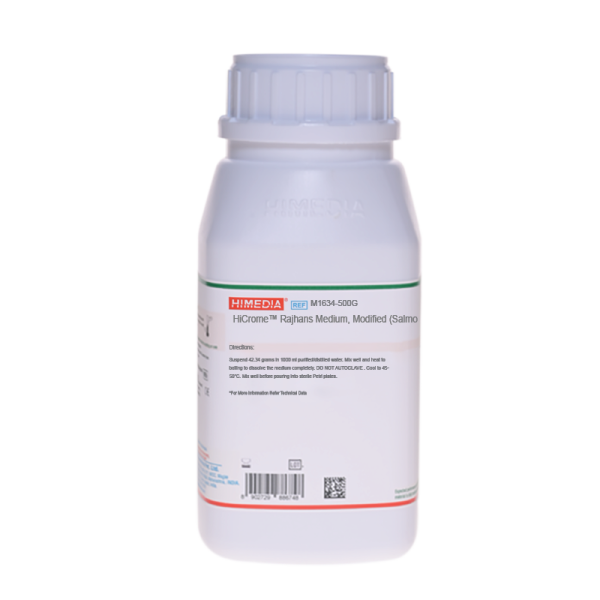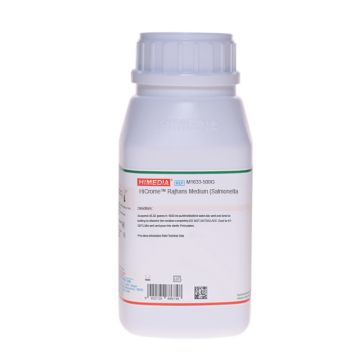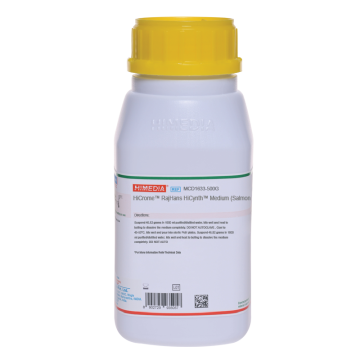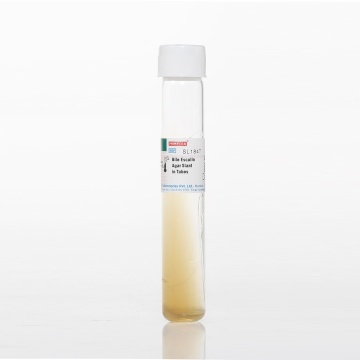 Your enquiry has been submitted
Your enquiry has been submitted
HiCrome™ RajHans Medium, Modified (Salmonella Agar, Modified)
Intended Use
Recommended for identification and differentiation of Salmonella species from the members of Enterobacteriaceae, especially Proteus species.
Composition**
| Ingredients | g / L |
|---|---|
| Tryptone | 8.000 |
| Yeast extract | 5.000 |
| Peptone | 4.000 |
| Sodium chloride | 5.000 |
| Sodium deoxycholate | 1.000 |
| Agar | 12.000 |
| Neutral red | 0.020 |
| Lactose | 3.000 |
| Chromogenic mixture | 4.320 |
Final pH ( at 25°C): 7.3±0.2
**Formula adjusted, standardized to suit performance parameters
Directions
Suspend 42.34 gram in 1000 ml purified/distilled water. Mix well and heat to boiling to dissolve the medium completely. DO NOT AUTOCLAVE. Cool to 45-50°C. Mix well and pour into sterile Petri plates.
Principle And Interpretation
HiCrome™ RajHans Medium, Modified is a modification of the original formulation of Rambach (1), used for differentiation of Salmonella species from Proteus species and other enteric bacteria. The original formulation is based on the novel characteristic of Salmonella species to produce acid from propylene glycol, which is detected by indicators present in the medium. These media are unique, because it is not based on acid production by propylene glycol. These media like many other media such as SS Agar, XLD Agar, recommended for the identification and differentiation of Salmonella species are based on lactose fermentation (2).
Tryptone, peptone and yeast extract supports the luxuriant growth of bacteria by providing carbonaceous, nitrogenous, vitamin B complex and other essential nutrients. Sodium deoxycholate inhibits gram-positive organisms rendering the medium selective for enteric microorganisms. The chromogenic mixture incorporated in the medium yields pink to red colonies of Salmonella. Lactose fermenting organisms form light purple to blue violet colonies. Other enteric gram-negative bacteria form colourless colonies.
Type of specimen
Clinical: faeces, urine, etc.; Water samples; Food samples
Specimen Collection and Handling
For clinical samples follow appropriate techniques for handling specimens as per established guidelines (3,4).
For food samples, follow appropriate techniques for sample collection and processing as per guidelines (5).
For water samples, follow appropriate techniques for sample collection, processing as per guidelines and local standards (6).
After use, contaminated materials must be sterilized by autoclaving before discarding.
Warning and Precautions
In Vitro diagnostic use. For professional use only. Read the label before opening the container. Wear protective gloves/protective clothing/eye protection/face protection. Follow good microbiological lab practices while handling specimens and culture. Standard precautions as per established guidelines should be followed while handling clinical specimens. Safety guidelines may be referred in individual safety data sheets.
Limitations
- The medium is selective for Salmonella may not support the growth of other microorganisms.
- Most of the Salmonella strains show pink-red colonies except few which may show colorless colonies.
- Due to nutritional variations, some strains may show poor growth.
- Final confirmation of suspected colonies must be carried out by serological and biochemical tests.
Performance and Evaluation
Performance of the medium is expected when used as per the direction on the label within the expiry period when stored at recommended temperature.
Quality Control
Appearance: Light yellow to beige homogeneous free flowing powder
Gelling: Firm, comparable with 1.2% Agar gel.
Colour and Clarity of prepared medium: Light orange coloured, clear to slightly opalescent gel forms in Petri plates
Reaction: Reaction of 4.23% w/v aqueous solution at 25°C. pH : 7.3±0.2
pH: 7.10-7.50
Cultural Response: Cultural characteristics observed after an incubation at 35-37°C for 24-48 hours.
| Organism | Inoculum (CFU) | Growth | Recovery | Colour of colony |
|---|---|---|---|---|
| Escherichia coli ATCC 25922 (00013*) | 50-100 | luxuriant | >=50% | light purple |
| Klebsiella pneumoniae ATCC 13883 (00097*) | 50-100 | luxuriant | >=50% | blue-violet |
| Salmonella Enteritidis ATCC 13076 (00030*) | 50-100 | luxuriant | >=50% | pink-red |
| Proteus mirabilis ATCC 25933 | 50-100 | luxuriant | >=50% | colourless |
| Salmonella Typhimurium ATCC 14028 (00031*) | 50-100 | luxuriant | >=50% | pink-red |
| Salmonella Typhi ATCC 6539 | 50-100 | luxuriant | >=50% | colourless |
| Shigella flexneri ATCC 12022 (00126*) | 50-100 | luxuriant | >=50% | colourless |
| Staphylococcus aureus subsp. aureus ATCC 25923 (00034*) | >=104 | inhibited | 0% |
Key: (*) Corresponding WDCM numbers
Storage and Shelf Life
Store between 15-25°C in a tightly closed container and the prepared medium at 2-8°C. Use before expiry date on the label. On opening, product should be properly stored dry, after tightly capping the bottle in order to prevent lump formation due to the hygroscopic nature of the product. Improper storage of the product may lead to lump formation. Store in dry ventilated area protected from extremes of temperature and sources of ignition Seal the container tightly after use. Product performance is best if used within stated expiry period.
Disposal
User must ensure safe disposal by autoclaving and/or incineration of used or unusable preparations of this product. Follow established laboratory procedures in disposing of infectious materials and material that comes into contact with clinical sample must be decontaminated and disposed of in accordance with current laboratory techniques (3,4).
Reference
- Rambach A., 1990, Environment. Microbiol, 56:301.
- Greenberg A.E., Trussel R.R., Clesceri L.S., (Eds.), (1985), Standard Methods for the Examination of water and waste water, 16th ed., APHA, Washington, D.C.
- Isenberg, H.D. Clinical Microbiology Procedures Handbook. 2nd Edition.
- Jorgensen, J.H., Pfaller , M.A., Carroll, K.C., Funke, G., Landry, M.L., Richter, S.S and Warnock., D.W. (2015) Manual of Clinical Microbiology, 11th Edition. Vol. 1.
- Salfinger Y., and Tortorello M.L. , 2015, Compendium of Methods for the Microbiological Examination of Foods, 5th Ed., American Public Health Association, Washington, D.C.
- Lipps WC, Braun-Howland EB, Baxter TE,eds. Standard methods for the Examination of Water and Wastewater, 24th ed. Washington DC:APHA Press; 2023.
| Product Name | HiCrome™ RajHans Medium, Modified (Salmonella Agar, Modified) |
|---|---|
| SKU | M1634 |
| Product Type | HiCrome™ |
| Physical Form | Powder |
| Origin | Animal |
| Packaging type | HDPE |
| References | 1.Rambach A., 1990, Environment. Microbiol, 56:301.2.Greenberg A.E., Trussel R.R., Clesceri L.S., (Eds.), (1985), Standard Methods for the Examination of water and waste water,16th ed., APHA, Washington, D.C. |
| Customized Product Available | No |









